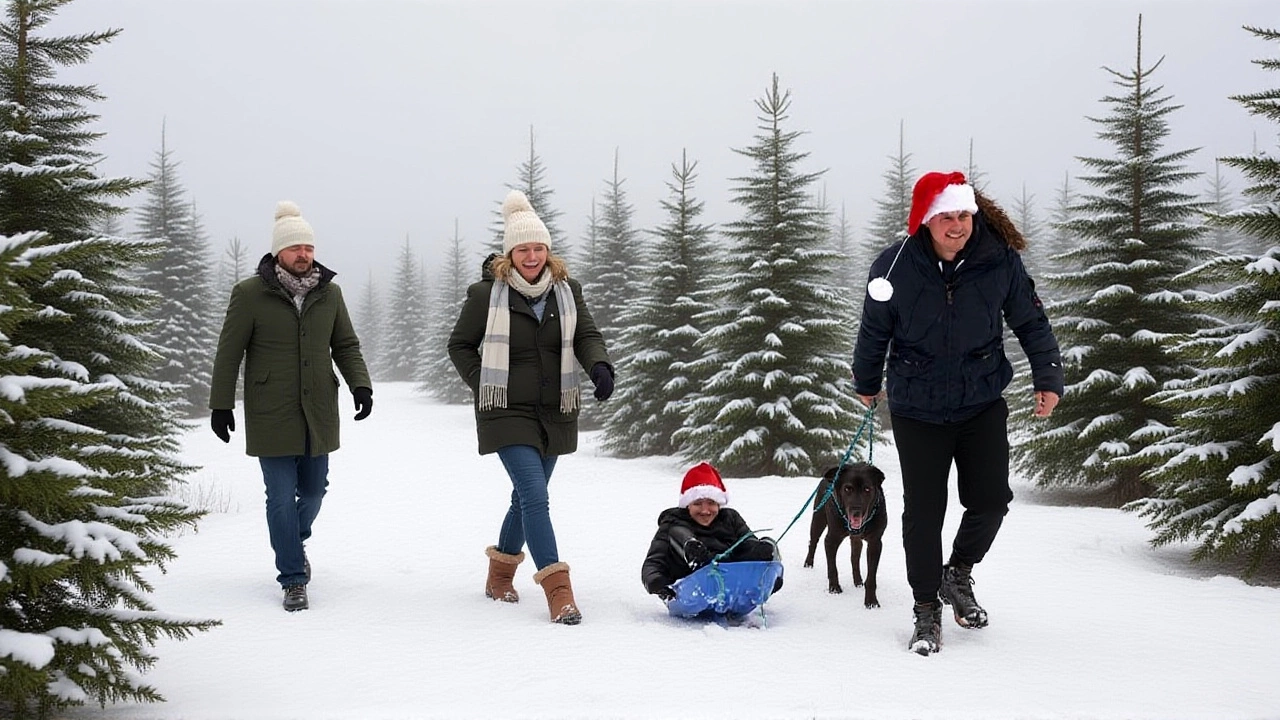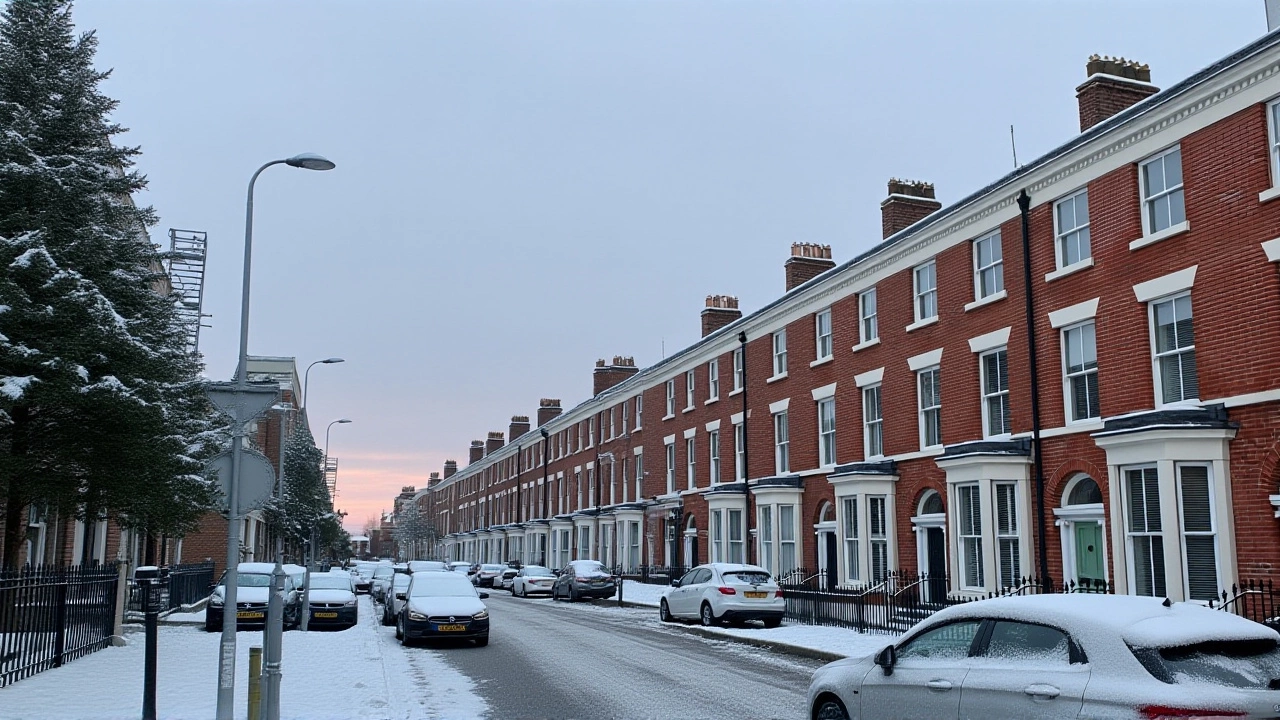Winter 2025 in the UK was warmer than most residents remembered, with the Met Office confirming a provisional mean temperature of 4.62°C — 0.53°C above the 1991–2020 average. That makes it the fifth warmest December on record, even as January turned chilly and February crept back above average. Rainfall was below normal at 308.0 mm (89% of the long-term average), and sunshine hours barely missed the mark at 94% of expected levels. The season was shaped by relentless low-pressure systems, including Storm Darragh, which slammed Wales and southwest England with gales and torrential rain from December 6–8, 2024. By Christmas Eve, the pattern had shifted again — and for many, the question wasn’t whether it would snow, but whether they’d even see a flake.
Christmas Day 2025: A Wet, Not White, Holiday
For Liverpool, Christmas Day 2025 looked more like a damp November afternoon than a festive snowscape. Forecasts from weather2travel.com pointed to a daytime high of just 7°C, with nighttime lows hovering near 2°C. Eight hours of daylight stretched between sunrise at 08:24 and sunset at 15:56, with sea temperatures clinging to a chilly 8°C. Rain was all but guaranteed — 18 days of precipitation in December, totaling 72 mm. One hour of sunshine per day? That’s not a holiday card. That’s a weather report from a gloomy Monday in January.
Across England, temperatures danced between 4°C and 10°C, with the south generally milder. But the real story wasn’t the warmth — it was the absence of snow. The Met Office defines a "white Christmas" as a single snowflake falling anywhere in the UK between midnight and midnight on December 25. Not accumulation. Not a dusting. Just one flake. Since 1960, roughly half of all Christmas Days have met that bare minimum. The last four years — 2020 through 2023 — all technically qualified, with snow recorded at 6% to 11% of weather stations. But in none of them did children build snowmen. In none did streets turn white.
Why Snow Wasn’t in the Cards
A YouTube analysis titled "Christmas 2025 weather – a fun and super speculative second peek," posted November 25, 2025, offered a surprisingly detailed glimpse into the atmospheric mechanics. The model showed a "vigorous westerly flow" pushing moist Atlantic air into the UK. Meanwhile, a cold pool drifted eastward — but not cold enough. At 850 hPa, temperatures sat above the 30-year average. "Were it to be correct," the analyst noted, "snow on Christmas Day would be very unlikely. Apart from maybe the Scottish mountains."
Pressure anomalies told the same story: a big positive anomaly over northeastern UK, negative over the Atlantic. That meant the low-pressure system over southern Iceland was pulling air in from the west — strong, moist, and above freezing. Snow? Only possible where the ground was already cold enough — high elevations in the north. Even then, the chances were slim.
Meanwhile, in Liverpool, the early days of December 2025 were cooler than average, with temperatures hovering around 9°C — a brief chill before the warm-up. The Met Office’s own data showed December 2024 ended with frosty mornings and settled conditions, but that pattern didn’t repeat. By Christmas, the UK was under "darker pink shading" on their forecast maps — the color code for above-average temperatures. No snow. No ice. Just damp wool coats and soggy pavements.

What This Means for the Future
This winter wasn’t an outlier. It was a trend. The UK has seen 13 of its 15 warmest winters since 2000. The long-term average for December snowfall has dropped by nearly 40% since the 1970s. Coastal cities like Liverpool, where sea temperatures hover around 8°C in winter, are becoming even less likely to see snow. Even the Scottish Highlands — once a reliable winter wonderland — are seeing shorter snow seasons and more rain-on-snow events.
It’s not just about Christmas. It’s about infrastructure. Roads designed for snow aren’t maintained for icy rain. Public transport systems aren’t equipped for slush. And for many, the loss of a white Christmas isn’t nostalgia — it’s a quiet signal that the climate is shifting underfoot.

What’s Next?
The Met Office will release its final winter report in March 2026, but early data suggests the trend won’t reverse. February 2025 ended with above-average temperatures and below-average snowfall across northern England. The next major test comes in December 2026. Will the Atlantic continue to dominate? Will the cold pools weaken further? Or will a rare easterly surge bring back the chill?
For now, the best advice for holiday travelers? Pack waterproofs. Leave the boots at home. And if you’re hoping for a snowman? You might want to visit the freezer instead.
Frequently Asked Questions
How likely is a white Christmas in the UK today compared to the past?
Since 1960, about half of all Christmas Days have technically qualified as "white" under the Met Office’s definition — just one snowflake falling anywhere in the UK. But in the 1970s, snow settled on the ground for an average of 4.2 days in December. Today, that’s down to 3.0 days. The last time a significant snowfall covered the ground on Christmas Day was 2010. Since then, even "white" Christmases have been fleeting and sparse.
Why does Liverpool rarely get snow on Christmas Day?
Liverpool’s coastal location means its sea temperatures remain relatively warm — around 8°C in winter — which keeps the air above freezing. The city also sits in the path of prevailing westerly winds that bring moist Atlantic air, not cold continental air. Even when snow falls elsewhere, it often turns to rain before reaching the Mersey. Historical data shows Liverpool averages only 1.2 snowy days in December.
What role did Storm Darragh play in shaping Winter 2025?
Storm Darragh, which hit from December 6–8, 2024, was the season’s first major disruption, bringing heavy rain and gales to Wales and southwest England. It set the tone for an unsettled winter — low pressure dominated the first half of December. But after Darragh passed, the pattern shifted. High pressure briefly brought cold, then gave way to stronger westerlies. The storm didn’t cause snow, but it helped lock in the wet, mild pattern that persisted through Christmas.
Are UK winters getting milder because of climate change?
Yes. The UK has warmed by about 1.2°C since pre-industrial times, with winter temperatures rising faster than summer ones. Eleven of the 15 warmest winters on record have occurred since 2000. The Met Office attributes this to greenhouse gas emissions and changing jet stream patterns. The decline in snowfall — especially in lowland areas — is one of the most visible signs of that shift. What was once a seasonal norm is now becoming a rarity.
What’s the difference between a "white Christmas" and a snowy Christmas?
A "white Christmas" only requires one snowflake to be observed falling anywhere in the UK during the 24 hours of December 25. It doesn’t need to stick. A snowy Christmas means snow accumulates on the ground — which is far rarer. Since 1960, only 38% of years have seen snow lying on the ground at 09:00 on Christmas Day. In 2023, 11% of stations recorded snowfall — but none reported snow cover at 09:00.
Where in the UK is snow still likely on Christmas Day?
The Scottish Highlands, particularly the Cairngorms and Grampians, remain the most reliable spots. Higher elevation means colder air and longer-lasting snow. Even there, snow cover is less consistent than in the 1980s. The Lake District and Pennines occasionally see snow, but it rarely lasts. In England, places like Altnaharra in Sutherland or the summit of Ben Nevis have the best odds — but even they’re seeing fewer snow days each year.
